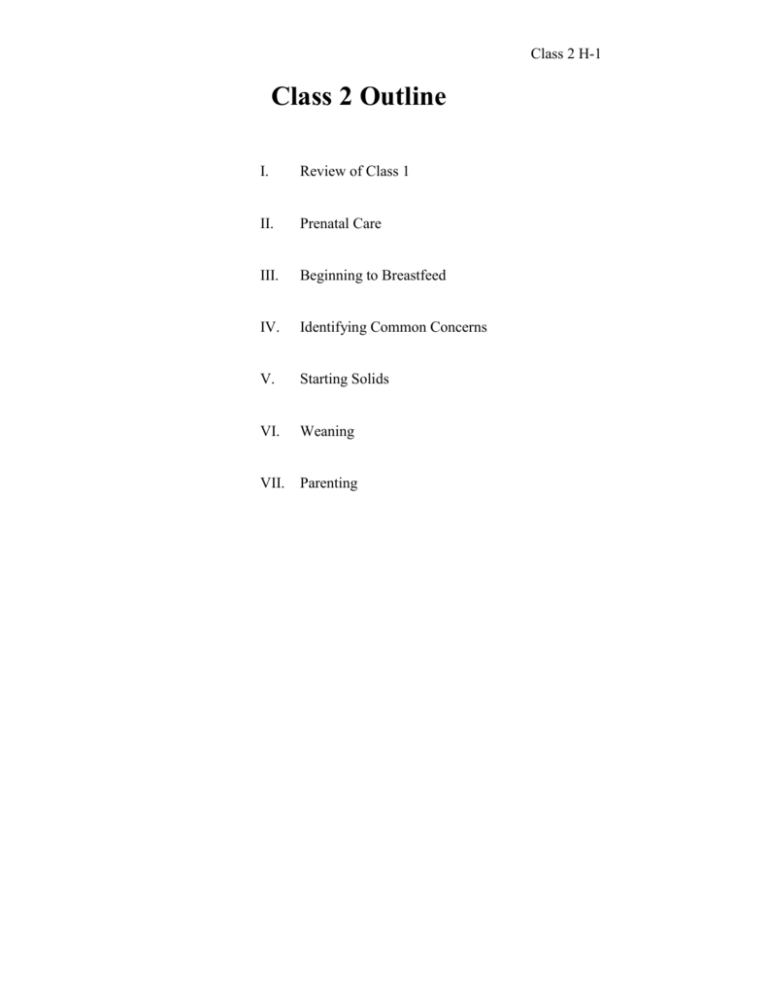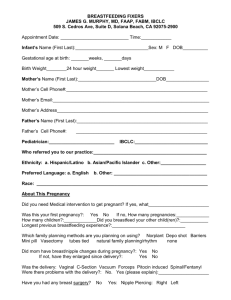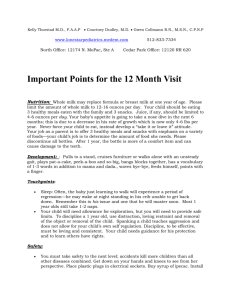Class 2
advertisement

Class 2 H-1 Class 2 Outline I. Review of Class 1 II. Prenatal Care III. Beginning to Breastfeed IV. Identifying Common Concerns V. Starting Solids VI. Weaning VII. Parenting Class 2 H-2 Class 1 Review 1. What are your favorite advantages of breastfeeding? Mother: 1. 2. 3. Baby: 1. 2. 3. Family: 1. 2. 3. 2. Breastmilk has ingredients that are especially good for the baby. Name three. What makes them special? 1. 2. 3. 3. What is the first milk produced by the breast?________________ Why is it so good for the baby? 4. Explain why you would need to know the difference between foremilk and hindmilk when counseling a breastfeeding mother. Class 2 H-3 Class 1 Review - Cont. 5. If a mother catches a cold, should she keep nursing her baby? Why? 6. Label the parts of the breast: 7. Why is breastmilk better for a baby than formula? 8. How would you teach a mother to burp her baby? 9. Can you spoil a baby? ____________ 10. Does a mother need to drink milk to make milk? _______________ 11. Does a mother have to be on a special diet to breastfeed?_________ 12. Can a baby be allergic to breastmilk? ______________ Class 2 H-4 Preparation for Breastfeeding Many women want to know what they can do in pregnancy to prepare their bodies for breastfeeding. After checking for flat or inverted nipples, no further preparation is needed, but some women feel more confident if they can be "doing something" positive. The best preparation is gathering information about breastfeeding, reading about breastfeeding, and talking to other mothers who were successful at breastfeeding. Remind Mothers: No Soap Do not to use soap or alcohol on the breasts while pregnant or breastfeeding. Soap and alcohol can dry out the skin and cause the areola to crack. No Creams The Montgomery Glands secrete oil that lubricates the areola. Colostrum that sometimes leaks out in pregnancy can be rubbed on the areola. Some women will ask about vitamin E oil or lanolin. Fancy creams and oils are not needed in pregnancy and may interfere with the natural oils produced by the Montgomery Glands. Nursing Pads Do not use nursing pads with plastic liners. Anticipating Breastfeeding You can help mother a get off to a good start by preparing her for the first few feedings. Discuss the pamphlet: “An Instructional Guide for Giving Your Baby the Best.” Emphasize the section on how to tell when baby is hungry. Give mother a crib card. This will remind her to let hospital staff know she plans to breastfeed. Nipple Evaluation Most babies can latch on to any size or shape nipple. However, some babies have trouble with inverted nipples. How To Tell mother to roll the nipple between her fingers to stimulate it, and watch the change in the nipple. Some nipples look like they protrude, but will actually invert when tested. Warning: Nipple preparation is not recommended. No nipple preparation or stimulation should cause pain or discomfort. Be gentle with any touch to the breast. Class 2 H-5 Preparation for Breastfeeding (cont.) If a mother is concerned about the size or shape of her breast... Refer her to your Breastfeeding Coordinator, a lactation consultant or her doctor for further evaluation. Common nipple: Protrudes slightly when at rest and becomes erect and more graspable when stimulated. This is the most common and causes no problems. Flat nipple: With stimulation, nipple basically stays the same, making it difficult for baby to find and grasp. This type of nipple benefits from nipple preparation. Semi-inverted nipple: Upon stimulation it retracts, making nursing difficult. Responds well to breast shells. Truly inverted nipple: Retracted at rest and when stimulated. Very uncommon, but very difficult to nurse on this nipple. Use all techniques to help them bring out the nipple. Correcting Flat or Inverted Nipples There are some techniques used to help correct flat or inverted nipples that may help the nipple protrude. These techniques can be used after the baby is born. Prenatal nipple preparation is not recommended. Nipple stimulation and preparation may cause uterine contractions in some women (especially women with a history of difficult pregnancies and/or miscarriages). Class 2 H-6 Nursing Bras Some women wear bras and some do not. There is no evidence that women need to wear a bra or that wearing a bra will prevent a woman’s breasts from sagging. Many women will feel better if the breasts are supported by a good bra. Why buy a nursing bra? Nursing bras make it easier for mom to uncover the breast when it is time for the baby to nurse. She usually will only need to use one hand. When to buy To insure a proper fit, it is better to wait until after the baby is born to buy a nursing bra. Never buy a nursing bra by your pre-pregnancy size. It's a good idea to try a nursing bra on before you buy one. What kind? Look for a COTTON bra without elastic straps; make sure there is an extra inch of room for expansion of the breasts after delivery, when the milk starts to come in. Selecting a COTTON bra is important because bacteria can grow inside a bra made of synthetic material. Look for a bra that makes breasts easily accessible with only one free hand. "Nursing" bras sometimes cost more than another bra that would serve just as well. Some cotton bras, especially those that clasp in front, can substitute for nursing bras. But be sure any bra, including an underwire bra, is not too tight. Tight bras can cause plugged ducts. Class 2 H-7 Tips for Helping Mothers with Breastfeeding Whenever possible teach pregnant moms about good positioning and latch. Even hospitals with lactation programs and peer counselor services may not have someone available to assist every mother with her first nursing session. Since lactation experts agree on the importance of a good latch to the success of the breastfeeding experience this information may make the difference in whether the nursing experience will get off to a good start. Teaching how-tos may be just as important as teaching advantages of breastfeeding prenatally. In addition, the majority of the breastfeeding mothers who ask for assistance may have their problems quickly resolved with corrected latch Keys for helping a mom with latch: •Be patient. Give mom and baby time to learn how to nurse effectively. Let moms know that breastfeeding takes practice. Always, ask permission before touching a mother or baby. Touching without permission is battery. •Try to talk the mom through correcting positioning. Make sure HER HANDS are on the baby - NOT YOURS. If you need to help, put your hands over hers. Or, briefly show her what to do then get your hands away, so she is in control. Remember, you are not going home with her, she needs to be confident she can do this herself. You are not doing her or the baby a favor if you do everything for her. •Check for signs of a good latch-on: Is about an inch to an inch and a half beyond the base of the nipple in the infant’s mouth? Is more of the areola below the nipple in the infant’s mouth than above the nipple? Are the lips flanged? Are the baby's ears and lower jaw moving? Remember the saying, “Chest to Chest, Nose to Breast.” •If the baby's nose is touching the breast, he is attached well and can still breathe. If the mother is concerned about making an air passage she can lift the breast with her supporting hand or pull the baby’s bottom a little closer to her, this will move the nose slightly back. Pressing on the breast with a finger to keep it away from baby's nose can disturb the latch-on, cause soreness and possibly a plugged milk duct. •If it hurts, start over. To break the suction, place your finger between the baby's gums or gently pull down on baby’s chin. •Baby will come off the breast by himself at the end of a feeding. When baby is satisfied (usually asleep) he will release the breast. Mom should not overly worry about switching breasts or nursing both breasts at a feeding. Babies need to nurse long enough at one breast to get the hind milk. She can nurse the breast that seems fuller first at the next feeding. Class 2 H-8 Tips for Helping Mothers Start and End a Feeding Many counselors keep this sheet by the phone. 1 2 3 4 5 6 Put a pillow on your lap to bring your baby up to the breast. Hold your baby with his chest to your chest and his lower arm around your waist. Your nipple needs to be right at his nose, so he doesn’t have to turn to reach it. The baby’s ear shoulder and hip will be in a straight line. Remember the saying, “Chest to Chest, Nose to Breast.” Hold your breast between your thumb and first finger. Keep your hand behind the brown part around your nipple. Your nipple should be aimed at baby’s nose. Wait until baby opens his mouth wide, as if to yawn. Quickly aim your nipple toward the roof of his mouth and draw him in very closely to your body. Baby should take the entire nipple and at least part of the brown part around the nipple into his mouth (about an inch to an inch and a half beyond the base of the nipple) Baby’s lips should be flanged and the cheeks should not be sucked in. Pulling the baby in closely causes him to remain correctly positioned on your breast. Pull the baby’s bottom toward you or lift up with the hand holding your breast to make an airway for his nose if needed. If it hurts when baby nurses, break the suction by putting your finger in the corner of her mouth between the gums or gently pressing on your breast or the baby’s chin and start over. Babies should nurse until they are satisfied or fall asleep at the breast. Class 2 H-9 Recommendations for Feeding Babies The American Academy of Pediatricians issued an infant feeding statement in 2005 recommending breastfeeding for at least a year and advising waiting until after six months of age to introduce solid foods. How Babies Grow Typically, a baby will gain weight steadily according to the following pattern: First 3 to 4 months: gain 4 to 8 ounces each week From 4 to 6 months: gain 3 to 5 ounces each week From 6 to 12 months: 1 ½ to 3 ounces per week After 1 year: maintain their growth curve percentile Growth Spurts Babies will increase their nursing frequency in order to build up the mother’s milk supply during growth spurts. For two or three days the baby will ask to nurse much more frequently. If the mom nurses him more frequently, her supply will increase. Then the baby will return to his normal routine. Growth spurts will happen around: 7 to 10 days 3 weeks 6 weeks then every couple of months Nurse often Nurse your baby when the baby is fussy or seems hungry. Newborns nurse every 1 ½ to 3 hours - 8 to 12 times in 24 hours. Breastfed infants tend to consume only as much milk as they need; bottle-fed babies may overfeed. Supplemental Bottles It is a good idea to get breastfeeding off to a good start before a supplementary bottle is introduced. Encourage mother to wait until her milk supply is well established, about 4-6 weeks. Class 2 H-10 Breastmilk is the first choice to put in the bottle. Have another person offer the bottle to the baby. Make it a social occasion as opposed to a feeding. Infant formula is the only acceptable alternative to breastmilk. Do not feed cows’ milk to babies under one year of age. Cows’ milk is poorly digested by babies. It can also trigger milk allergy. If a mother chooses to give her baby a supplemental bottle, advise the mother to hold her baby while feeding. Bottles should not be propped, because babies may choke. Formula feeding If formula-feeding, refer questions to WIC staff. Solids Solids should not be introduced before six months of age. Cereal does not contain the same nutrients as breastmilk, so if baby fills up on cereal, he is not getting what he needs to grow. Also, solids given too early can cause allergies, upset stomach, constipation or diarrhea. Your baby is ready for foods other than breastmilk when he can: 1. Sit with a little support. 2. Control his head and neck movements. 3. Tell you he is hungry or full by leaning forward with an open mouth or pulling away and turning his head.



